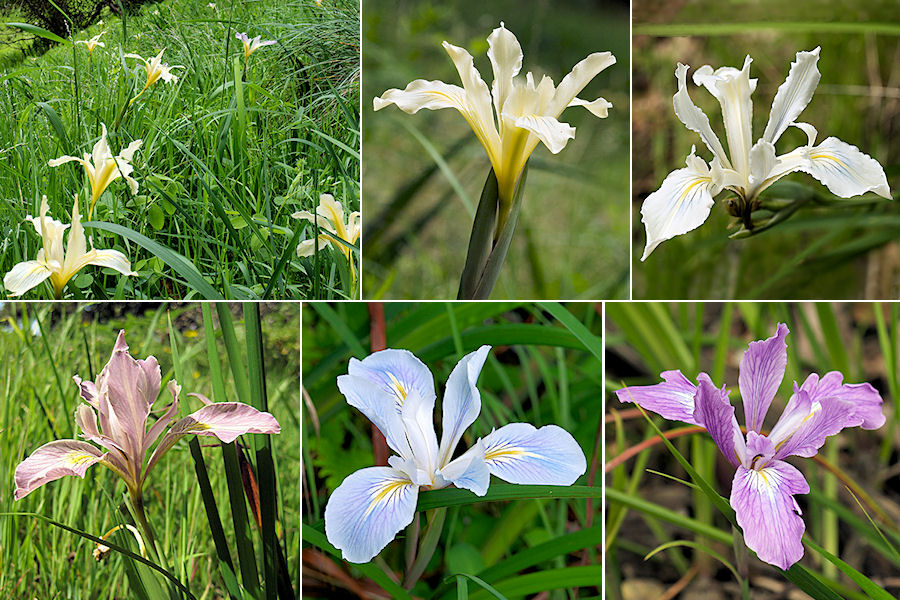Marin Iris and Santa Cruz Iris
"The delicacy of forms and the fine shadings of color combine to make the Marin iris one of the chief floral delights of the vernal woodlands." - - John Thomas Howell, Marin Flora (1949).
In the shaded forests of California's Coastal Range north and south of the Golden Gate, the iris you'll most often run across will have large yellow, white, brown or lavender-flowers. These populations are a field laboratory of natural hybridization, welcoming anyone who likes the challenge of a good puzzle.

Marin Iris examples. Above: (L) - Tom Ballinger. Carson Ridge, Fairfax CA April 23, 2011. (C) - Eric Hunt. Carson Ridge, Fairfax CA April 23, 2011. (R) - Eric Hunt, ibid. Below: (L) - Anonymous. Indian Valley Open Space, Novato, CA March, 2010. (C) - Ballinger, ibid. (R) - Eric Hunt, ibid.
Since the end of the last Ice Age, at least three parent gene pools seem to have been actively mixing their components to find a "best fit" hybrid for each microhabitat. 1 - Broad-leaved, purple-flowered Iris douglasiana inhabits the exposed chaparral and grasslands along the Pacific Coast. 2 - Narrow-leaved, purple-flowered Iris macrosiphon is the iris of warm, sunny, inland grasslands and meadows. 3 - And yellow-flowered Iris fernaldii is the understory iris of the humid shaded forests in the central regions of the inner and outer Coastal Ranges. Fernald's iris apparently no longer exists in its pure form in Marin County, althouth it can be common in nearby woodlands to the north and east - habitats now separated by treeless grasslands and pastures from the forests around Mount Tamalpais.
In older books, you can find these hybrid iris referred to simply as "yellow Douglas iris", as a race of Douglas iris (I. douglasiana major) or a variety (I. douglasiana var. major), as a distinct species (Iris major), or as an unnamed hybrid: (I. douglasiana X I. fernaldii). In 1959, Dr. Lee Lenz suggested using the names "Marin Iris" for the hybrid plants growing north of the Golden Gate around Mount Tamalpais in Marin County, and "Santa Cruz Iris" for their relatives growing south of the Golden Gate between San Francisco and Santa Cruz counties.
As a general rule, for both the Marin and Santa Cruz iris:
- Flower color is most often pale yellow, but it varies widely. In a small area you can see pure snow-white flowers beside others cream-color or pale yellow, shades of brown to white or yellow with a lavender blush on the petals, or lavender with darker purple veins. When present, the signal spot is usually yellow.
- Yellow-flowered plants mostly live on shaded woodland slopes with only dappled sunlight. In adjacent sunny meadows, you find purple Iris macrosiphon. And the open chaparral / grasslands usually within sight of the coast are the exclusive territory of true Iris douglasiana. At the interface, where one habitat stops and another begins, you'll recognize plants with clear features of two or three parents.
- Yellow flowered iris with 2- to 4-inch long floral tubes occur close to the sunny meadows inhabited by typical I. macrosiphon.
- Typically, these plants have the robust structure of a Douglas iris, with broad bifacial leaves (one side shiny, the other dull), and ovaries triangular in cross section and a nipple-like projection where the tube begins. The other parents have narrower leaves, and you'll see plants with leaves from narrow to broad.
- Most hybrids in shaded forest settings are single plants, usually not forming larger clumps like the Douglas iris along the coast.
- The hybrid iris' stalks are usually unbranched; Douglas iris stalks are often branched.
Additional Marin Iris resources:
- Brian Agron's enjoyable 11-minute video "The Iris of Marin" highlights plants he photographed along Mount Tamalpais trails near Fairfax. It connects us with an astonishing kalidoscope of colors (most are Marin Iris hybrids, with occasional Iris macrosiphon). Be sure to have your sound turned on!
- Eric Hunt and Tom Ballinger put together separate, colorful online photo sets of Marin Iris hybrids (most labeled as "Douglas Iris") seen in April 2011 along Carson Ridge north of Alpine Lake and Mount Tamalpais. Many of the plants have strong Iris douglasiana features – short flower stems, broad leaves, and multiple flowers on the stem. The two galleries also include several fine examples of open grassland Iris macrosiphon.